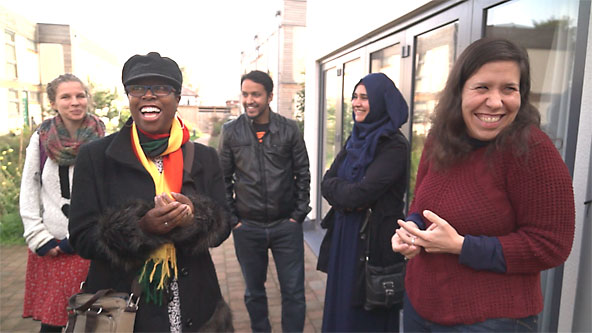Cohousing
Imagine living on a street where you get to choose your neighbours – and the reason you’re living there is because all your neighbours have chosen you…
Everyone has an equal say in how things run: what the rent levels should be, what repairs need doing, and whether or not to spend some of the street’s money on a new playground.
As well as their own private homes, everyone on the street also has the use of some shared facilities in the “common house” – washing machines, guest rooms (for when their relatives come to stay) and a big kitchen and dining room where everyone can eat together two or three times a week.
There’s a real sense of everyone looking out for each other – an informal and friendly mutual support network where people look after each others’ kids and rally round with meals when someone’s ill. Few people own cars, but instead will book one from the local car pool when needed.
There are – of course – occasional disagreements, but everyone’s committed to helping people resolve any issues that crop up, and there’s a fair process for decision-making that everyone’s signed up to.
On top of all that, the houses use very little energy to run (so, tiny heating bills) and there’s plenty of safe play-space and opportunities for growing your own food in the big shared garden.
The essentials of cohousing
According to the UK cohousing Network website…
Cohousing is a way of living which brings individuals and families together in groups to share common aims and activities while also enjoying their own self-contained accommodation and personal space.
Cohousing communities are a means of compensating for the alienating effects of modern life where neighbours don’t recognise each other and where day-to-day collaboration is minimal. They offer particular benefits for children in terms of secure play-space and shared activities with their peers. Older people can also find companionship and mutual support in such communities.
The main features of cohousing communities are:
- They are set up and run by their members for mutual benefit
- Members are consciously committed to living as a community
- Developments are designed to encourage social contact and a sense of neighbourhood among members.
- Common space facilitates shared activities like community meals and other amenities like laundries, heating systems, guest rooms, transport, etc may be shared
You can see cohousing in action over in Bramley…
Why it appeals
Cohousing is more than just a nice idea. It’s a conscious attempt to find a better way of living – better for ourselves, our neighbours, our society and our planet.
People who find fulfilment in accumulating wealth and possessions are not likely to see the point of cohousing. One of the main motivations behind those of us currently involved in Chapeltown Cohousing is the desire to be part of a genuinely caring community, where neighbours are looking out for each other and enjoying doing things together.
But it goes deeper than that
We live in a world where…
- Half the population have less than £6 a day to live on
- Our own society consumes over three times its share of the planet’s resources
- Climate change threatens to destroy the lives of those who didn’t cause it
- Environmental destruction is driving a biodiversity “extinction event”
- Few politicians are prepared to question the pursuit of unending economic growth
- The global population triples in one lifetime.
It’s against that background that we’re looking for a way of living that’s more appropriate for these times. We want to live in a way that doesn’t use more than our fair share of the world’s resources – that’s characterised by sharing rather than greed, and points the way to a sustainable and fair future for all…
…and that doesn’t take itself too seriously…





